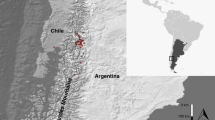Abstract
The sublittoral chironomid fauna of 22 lakes in Killarney Park, Ontario, Canada were examined for their response to different levels of acidification. Included in the analysis were naturally acidic lakes, lakes acidified by atmospheric deposition but now recovering, and unacidified circumneutral lakes. pH in the study lakes ranged from 4.6 to 7.7. No correlation was found between species richness and pH, nor between abundance and pH. Acid neutralizing capacity (ANC), the temperature at the sampling depth, pH, and dissolved organic carbon were the variables contributing significantly in a canonical correspondence analysis of the abundance data. ANC was the most important variable in describing the chironomid community, accounting for about 9% of the variance in the species data. This study is the first step in an effort to model the changes in the chironomid community of recovering acidified lakes and the results suggest that ANC may be an important predictor variable.
Similar content being viewed by others
References
Birks, H.J.B.: 1995, ‘Quantitative palaeoenvironmental reconstructions', in D. Maddy and J.S. Brew (eds.), Statistical modelling of quaternary science data, Technical Guide 5, Quaternary Research Association, Cambridge, pp. 161–254
Brandrud, T.E., Brettum, P., Dolmen, D., Halvorsen, G., Halvorsen, G.A., Lindstrøm, E-A., Raddum, G.G., Romstad, R., and Schnell, Ø.A.: 2000, Effects of liming on biodiversity. Results from 1997–98, the two first years after liming was started.Utredning for DN, Direktoratet for naturforvaltning, Trondheim. (In Norwegian).
Carbone, J., Keller, W. and Griffiths, R.W.: 1998, Restoration Ecology 6, 376.
Dermott, R.M.: 1985, Hydrobiologia 128, 31.
Dermott, R.M., Kelso, J.R.M. and Douglas A.: 1986, Water, Air and Soil Pollution 28, 283.
Gunn, J.M. (ed.): 1995, Restoration and Recovery of an Industrial Region. Progress in Restoring the Smelter-Damaged Landscape near Sudbury, Canada. Springer-Verlag, New York.
Halvorsen, G.A.: 1999, ‘Chironomids as indicators of acidification. Report from a pilot project in the Northern Lakes Recovery Study', in G.G. Raddum, B.O. Rosseland and J. Bowman (eds.), Workshop on biological assessment and monitoring; evaluations and models, ICP-Waters report 50/99, NIVA, Oslo, pp. 73–79.
Hindar, A. and Henriksen, A.: 1998, Mapping of Critical Load and Critical Load Exceedances in the Killarney Provincial Park, Ontario, Canada. NIVA Report 3889–98, NIVA, Oslo.
Johnson, R.K. and Goedkoop, W.: 1992, Neterlands Journal of Aquatic Ecoogy 26, 491.
Keller, W., Heneberry, J.H. and Gunn, J.M.: 1998, Journal of Aquatic Ecosysystems Stress and Recovery 6, 189.
Mossberg, P. and Nyberg, P.: 1979, Report Institute of Freshwater Research, Drottningholm 58, 77.
Raddum, G.G. and Sæther, O.A.: 1981, Verhandlungen Internationale Vereinigung für Theoretischen und Angewandte Limnologie 29, 399.
Snucins, E. and Gunn, J.M.: 1998, Chemical and Biological Status of Killarney Park Lakes (1995–1997). A study of lakes in the early stage of recovery from acidification. Ontario Ministry of Natural Resources, Cooperative Freshwater Ecology Unit., Sudbury, Ontario.
Snucins, E., Gunn, J.M., Keller, B., Dixit, S., Hindar, A. and Henriksen, A.: 2000, Journal of Environmantal Monitoring and Assesment (in press)
Stoddard, J.L., Jeffries, D.S., Lükewille, A., Clair, T.A., Dillon, P.J., Driscoll, C.T., Forsius, M., Johannesen, M., Kahl, J.S., Kellogg, J.H., Kemp, A., Mannio, J., Monteith, D.T., Murdoch, P.S., Patrick, S., Rebsdorf, A., Skjelkvåle, B.L., Stainton, M.P., Traaen, T.S., van Dam, H., Webster, K.E., Wleting, J. and Wilander, A.: 1999, Nature 401, 575.
ter Braak, C.J.F. and Smilauer, P.: 1998, CANOCO Reference Manual and User's Guide to Canoco 4.0 for Windows: Software for Canonical Community Ordination (version 4), Microcomputer Power, Ithaca, New York.
Wiederholm, T.: 1988, Spixiana (Supplement) 14, 7.
Wiederholm, T. and Eriksson, L.: 1977, Oikos, 29, 261.
Author information
Authors and Affiliations
Rights and permissions
About this article
Cite this article
Halvorsen, G.A., Heneberry, J.H. & Snucins, E. Sublittoral Chironomids as Indicators of Acidity (Diptera: Chironomidae). Water, Air, & Soil Pollution 130, 1385–1390 (2001). https://doi.org/10.1023/A:1013975905893
Issue Date:
DOI: https://doi.org/10.1023/A:1013975905893




